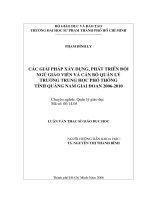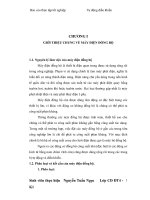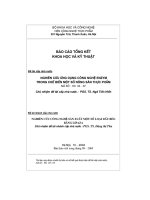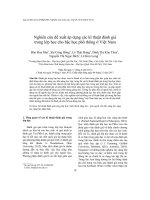Báo cáo nghiên cứu khoa học: "NGHIÊN CỨU VỀ ĐỘNG CƠ HỌC TIẾNG ANH CỦA HỌC SINH TRUNG HỌC PHỔ THÔNG Ở QUẢNG NAM" potx
Bạn đang xem bản rút gọn của tài liệu. Xem và tải ngay bản đầy đủ của tài liệu tại đây (147.91 KB, 9 trang )
TẠP CHÍ KHOA HỌC VÀ CÔNG NGHỆ, ĐẠI HỌC ĐÀ NẴNG - SỐ 5(34).2009
163
NGHIÊN CỨU VỀ ĐỘNG CƠ HỌC TIẾNG ANH CỦA HỌC SINH
TRUNG HỌC PHỔ THÔNG Ở QUẢNG NAM
AN INVESTIGATION INTO ENGLISH LEARNING MOTIVATION OF UPPER
SECONDARY SCHOOL STUDENTS IN QUANG NAM PROVINCE
Phan Văn Hoà
Trường Đại Học Ngoại ngữ, Đại học Đà Nẵng
Lê Viết Hà
Học viên cao học khoá 2006-2009 Đại học Huế
TÓM TẮT
Bài báo này bước đầu tìm hiểu mục đích , động cơ và một số yếu tố ảnh hưởng đến
động cơ học tiếng Anh của học sinh THPT ở Quảng Nam (QN). Chúng tôi sử dụng bảng điều
tra theo mô hình của Gardner gồm 8 đề mục tìm hiểu mục đích học tiếng Anh của học sinh
THPT và liệt kê 15 đề mục có khả năng ảnh hưởng đến động cơ học tiếng Anh. Đối tượng điều
tra gồm 100 học sinh ở 4 trường THPT ở QN. Kết quả cho thấy đa số học sinh ở QN có thái độ
và động cơ tích cực đối với việc học tiếng Anh. Tuy nhiên, đa số các em có động cơ công cụ
hơn là động cơ hội nhập . Hơn nữa, kết quả cũng chỉ ra rằng động cơ học tiếng Anh của học
sinh ở QN bị ảnh hưởng bởi các yếu tố liên quan đến môn học hơn là những yếu tố liên quan
đến giáo viên. Từ kết quả nghiên cứu, chúng tôi đề xuất một số giải pháp và kiến nghị góp phần
nâng cao chất lượng dạy và học tiếng Anh.
ABSTRACT
This study investigates English learning goals and motivation and some factors
influencing the motivation of upper secondary students in Quang Nam. A modified 8-item survey
adapted from Gardener’s AMTB and a 15 -possible demotivating factor survey are administered
to 100 upper secondary EFL students in four upper secondary schools in QN. The study reveals
that the students have positive attitudes toward learning English and are highly motivated to
study it, and that they are more instrumentally than integratively motivated. Moreover, the
students’ motivation is more demotivated by some subject-related factors rather than by
teacher-related ones. Based on these findings, some recommendations to promote students’
motivation in learning EFL and some pedagogical implications are provided.
1. Introduction
Motivation, believed as one of the most important factors determining the rate
and success of second language (L2) attainment, provides the primary impetus to
initiate learning the L2 and later the driving force to sustain the long and often tedious
learning process [3]. Without sufficient motivation, students cannot accomplish long-
term goals and we can not ensure their achievement, either. As [6] reiterate, “You can
lead a horse to water, but you cannot make him drink”. Research shows that motivation
is crucial for L2 learning [2]; [8] because motivation directly influences (1) how much
effort students make, (2) how often students use L2 learning strategies, (3) how much
students interact with native speakers, (4) how much input they receive in the language
TẠP CHÍ KHOA HỌC VÀ CÔNG NGHỆ, ĐẠI HỌC ĐÀ NẴNG - SỐ 5(34).2009
164
being learned, (5) how well they do on curriculum related achievement tests, (6) how
high their general proficiency level becomes, and (7) how long they preserve and
maintain L2 skills after language study is over [4] & [8]. However, in our local schools,
students are not highly or properly motivated. This leads to the fact that students seem
to lose their interests and confidence in learning English. In this case, the writers
investigate students’ motivation for foreign language learning, with the hope to answer
the following questions:
(1). What are the upper-secondary school students’ goals for learning English?
( 2). What kinds of motivation do the students have in learning EFL in QN?
(3). What are the factors influencing the motivation of EFL learners in QN?
(4). What should be done to promote students’ motivation in learning EFL in QN?
2. Research Methodology
The study employs quantitative and qualitative research methods.
2.1. Participants
100 students (male and female) from 4 upper secondary schools in QN,10
English teachers and 4 administrators from these schools are asked and interviewed.
Students’age range is from 16 to 18. They have studied English for 5 years.
2. 2. Data Collection
For the purpose of obtaining data that will explore why the upper-secondary
school students in QN learn English and what negatively affects their English learning
motivation, the researchers use the following tools for data collection:
- A questionnaire of two parts. The first is adapted from Gardner’s AMTB [5] to
measure the students’ integrative / instrumental motivation in learning English. This
contains 8 items reflecting the integrative / instrumental motivation and a five point
Likert Scale ranged from “strongly disagree” to “strongly agree”. The second is tailored
to explore the factors facing the English learners. The researchers generate 15 possible
factors depending on the results of relevant studies and experience teaching English
enables them to identify what affects English learning in Viet Nam’s context in general
and in QN’s in particular.
- Interviews with 20 students, 10 teachers, 4 administrators to obtain qualitative data.
2.3. Data Analysis
The analysis mainly focuses on studying students’ integrative and instrumental
motivations in learning English as well as the factors influencing them. The data from
questionnaires and interviews are analyzed in terms of statistical frequency basing on
percentages by means of tables and diagrams.
3. Findings and Discussion
3.1. Findings
TẠP CHÍ KHOA HỌC VÀ CÔNG NGHỆ, ĐẠI HỌC ĐÀ NẴNG - SỐ 5(34).2009
165
3.1.1. Integrativeness and Instrumentality
The respondents were asked to indicate on a five point scale to show how important
each reason was for English learning. The focus was on two types of motivational
orientation: Integrative and Instrumental [5]. Eight statements were designed to find out the
dominant reason among the upper secondary school students in QN.
Table 3.1: Integrative motivation (Frequency Distribution and Mean Score)
Q1 Q2 Q3 Q4
Score Frequencies % Frequencies
% Frequencies
% Frequencies
%
1 0 0 2 2 2 2 3 3
2 1 1 6 6 24 24 11 11
3 5 5 40 40 41 41 44 44
4 55 55 38 38 27 27 20 20
5 39 39 14 14 5 5 12 12
Total
100 100 100 100 100 100 100 100
Mean
4.32 3.56 3.06 2.97
Overall Mean Score: 3.48
Q1: I study English to be more at ease with English speakers.
Q2: I study English to meet and converse with varied people.
Q3: I study English to understand British and American arts and literature.
Q4: I study English to participate more freely in the activities of other cultural groups.
Table 3.2: Instrumental motivation (Frequency Distribution and Mean Score)
Q5 Q6 Q7 Q8
Score Frequencies % Frequencies % Frequencies % Frequencies %
1 0 0 1 1 0 0 9 9
2 0 0 3 3 0 0 18 18
3 4 4 23 23 4 4 37 37
4 17 17 42 42 26 26 29 29
5 79 79 31 31 70 70 7 7
Total
100 100 100 100 100 100 100 100
Mean
4.75 3.99 4.66 3.07
Overall Mean Score: 4.1
Q5: I study English as I need it for my future career.
Q6: I study English to become more knowledgeable.
TẠP CHÍ KHOA HỌC VÀ CÔNG NGHỆ, ĐẠI HỌC ĐÀ NẴNG - SỐ 5(34).2009
166
Q7: I study English as it helps me get a good job.
Q8: I study English as the others respect me more.
A close examination of the frequency distribution and mean scores of responses
to the four items comprising the integrative orientations indicates that the students have
high degree of integrative motivation. The mean scores of the items are over 3 except
item 4. With an overall mean score of 3.48, the students show a positive attitude toward
the L2 community and an agreement that studying English can allow them to interact
with other English speakers, to meet more variety of English speaking people, to
understand British and American arts and literature. However, over 50% of the
respondents express disagreement and uncertainty in viewing learning English as a
means to participate more freely in the activities of other cultural groups.
Table 3.1 and 3.2 show the respondents’ clear inclination towards instrumental
orientation. Whereas, only 14% of the informants accept they learn English ‘to meet and
converse with varied people’, 5% agree with the statement that ‘they learn English to
understand American and British arts and literature’. 12% agree that they learn English
‘to participate more freely in the activities of other cultural groups’. A higher
percentage: 79%, 70% agree with the respective statements they learn English because,
‘English is needed to the future career, to get a good and high ranking job’.
Additionally, the frequency distribution and mean scores of the 4 items making up the
instrumental orientation show the students highly accepted items 5, 6 and 7 (getting a
good job, improving future career and being a knowledgeable person) as being
fundamental reasons to their desire to learn English. Comparing the overall mean score
(3.48) of the four integrative items to (4.1) of the instrumental items as shown in figure
3.1, it can be concluded that the respondents are to a certain extent integratively
motivated but they still have a higher degree of instrumental motivation.
Figure 3.1: The overall means of students’ integrativeness and instrumentality
Instrumentality
3.48
4.1
3
3.2
3.4
3.6
3.8
4
4.2
Integrativeness
MEAN
3.1.2. The demotivating factors
The second part of the questionnaire was designed to investigate the factors
demotivating students when learning English. The question asked to recognize the
demotivating factors was “which one of the following factors demotivated you when
studying English”.
TẠP CHÍ KHOA HỌC VÀ CÔNG NGHỆ, ĐẠI HỌC ĐÀ NẴNG - SỐ 5(34).2009
167
Table 3.3: The frequency distribution and percentages of the demotivating factors facing students when
learning English. (n = 100).
Rank Item no. Demotivating factors Frequency Percentage
1 10 Spelling errors 90 90%
2 9 Listening skill difficulties 89 89%
3 7 Vocabulary load 70 70%
4 8 Difficulty of structure 34 34%
5 4 Rare use of technology 33 33%
6 1 Teachers’ rapid speech 31 31%
7 2 Rare use of Vietnamese 25 25%
8 3 Teachers’ personality 24 24%
9 6 Textbooks 20 20%
10 5 Evaluation system 17 17%
11 12 Parents’ discouragement 2 2%
12 13 Friends’ discouragement 2 2%
13 11 Effect of English on Vietnamese 0 0%
14 14 Social and religious reasons 0 0%
As seen in table 3.3, the most demotivating factors mentioned by the students
referred to the difficulty of English as a school subject. The first places in terms of
demotivating factors were occupied by some subject aspects: ‘spelling errors’ which
was considered the first demotivating factor by 90% of the respondents, ‘listening skill
difficulties’, 89%, ‘vocabulary load’, 70% and ‘difficulty of the structure’, 34%.
Moreover, some aspects of the teacher’s personality and style are still considered
demotivating by considerable percentage of respondents. Demotivating factors related
to textbooks was mentioned by 20% of the respondents whereas 17% feel demotivated
because of evaluation system reason.
Comparing the total frequencies of the subject demotivating factors (283) to the
teacher demotivating factor (113) as seen in figure 4.2 indicates that the students’
demotivation toward learning English is affected largely by the subject-related aspects.
Additionally, the results also show that the teachers of English in the upper secondary
schools in QN are not the most dominant demotivating factor for learning English.
TẠP CHÍ KHOA HỌC VÀ CÔNG NGHỆ, ĐẠI HỌC ĐÀ NẴNG - SỐ 5(34).2009
168
283
113
SA
T
Figure 3.2: Total frequencies of subject aspects and teacher as demotivators
Furthermore, the participants’ responses to the open ended question number 15
in the second part of the questionnaire in addition to the interviews clarified some points
and added others to the results. Most of the interviewees complained about the subject
demotivating factors such as the big amount of vocabulary to be memorized with their
meanings, the complexity of some structural rules like different types of reported
speech, the use of phrasal verbs and the use of prepositions, articles
3.2. Discussion
The results show that the students in QN have a higher degree of instrumental
orientations and motivation than the integrative ones. It can be noticed that this finding
is in line with the results of many related studies conducted in the Vietnamese context
[10]; [9]; [11]; [7] with slight difference concerning the rate of integrative motivation.
Those studies show low rates of integrativeness among the Vietnamese students, while
this study proves that the students in QN have a rather high level of integrative
motivation toward learning English (mean = 3.48). This is not surprising; because of
Viet Nam government’s “open - door”policy, students have more chance to integrate
with the other communities and nationalities.
In regard to the demotivating factors affecting learning English, the findings
reveal the teacher is not the dominant demotivating factor. In contrast, the subject
aspects are found to be in the first place in terms of demotivating factors. Moreover, the
study reveals the effect of textbooks, friends’ and parents’ discouragement on the
students’ motivation.
Although the results indicate the students in QN are instrumentally motivated
toward learning English, the respondents show a considerable amount of
integrativeness. As mentioned, having integrative motivation means being ready to
TẠP CHÍ KHOA HỌC VÀ CÔNG NGHỆ, ĐẠI HỌC ĐÀ NẴNG - SỐ 5(34).2009
169
integrate into the target language community and culture. It is also theorized that
integrative motivation typically underlies successful acquisition of a wide range of
registers and a native like pronunciation .
However, being integrative in context like in Viet Nam generally and in QN
particularly might be relatively different: Students expressed their desire to interact with
other speakers of English (94%), whereas 52% like to learn English to meet and
converse with varied people.
In regard to in QN’s context, the students’ considerable inclination to
integrativeness could be a result of the noticeable existence of the English speaking
people. The unique situation of QN - a destination of two world heritages - enables the
students to contact and make good relations with English speakers in universities, for
example and with tourists.
Concerning the demotivating factors, the authors will concentrate on the external
demotivating factors affecting the students’ motivation.
However, results of the survey and interviews show that demotivators related to
learning context are not the only type of demotivation. Another type of demotivation
related to some subject aspects is also referred to by a higher percentage. Additionally,
most of the demotivating factors in context in QN are in line with the demotivating
factors categorized by [8] and [3] particularly, teacher’s personality and teaching
methods, the negative attitudes toward L2 community, course book and reduced self
confidence. The discussion will be first about the subject demotivating factors since
they are the most frequent and the teachers as demotivators affect largely the language
and acquisition.
4. Implications and Recommendations
From the findings, some implications are suggested:
- Teachers, educators and syllabus designers should be sensitive to learners’ motives by
recognizing their instrumentality. Enhancing learners’ instrumentality can be easily
achieved by focusing more on practical skills such as how to communicate with others
fluently and express oneself correctly.
- English textbooks and examination system should be also modified to meet the
learners’ instrumental motives.
- Raising students’ integrativeness is necessary because both integrative and
instrumental orientations are required for real language acquisition and learning.
- Interests toward the English culture and literature can be raised by exposing learners to
more literary forms and by providing opportunities for communication with native
speakers. The lack of contact with L2 community affect developing positive attitudes
towards that community [1]. Therefore, major strategies for stimulating integrative
motivation should be followed by teachers.
TẠP CHÍ KHOA HỌC VÀ CÔNG NGHỆ, ĐẠI HỌC ĐÀ NẴNG - SỐ 5(34).2009
170
- The educational policy makers should make changes by reducing the load of
vocabulary which should be memorized for the sake of tests and providing more
attractive and motivating listening texts.
- One of the most important pedagogical implications derived from the findings is the
teacher’s role in shaping the learner’s motivation and attitudes. Moreover, the teacher’s
role should be accordingly adjusted. In addition to lecturers or instructors, the teacher
should also be a combination of several other roles. Teachers should create some school
activities which meet the students’ needs and learning goals instead of concentrating
solely on memorizing vocabulary and grammatical rules at the expense of the language
skills and actual language acquisition.
- Teachers should bear in minds that students have to be taught in a meaningful way to
master the language skills, be able to communicate fluently and use English in real
world situations.
- The integration of culture and language could function as a positive attitude and
further motivation to study a foreign language [5]. At the same time, teachers should
develop students’ cross cultural awareness systematically rather than simply adopting
the socio-cultural components to satisfy students’ integrative orientations [2].
- To respond to the students’ needs about tests, the teachers can reduce the students’
demotivation by allocating few periods before the final exams to review and train
students on test taking strategies.
- In order to utilize technology effectively in teaching English, schools should be
equipped with adequate numbers of technological devices.
5. Conclusion
Motivation plays an important role in the process of English learning – teaching.
The results of the research shows that to students in QN, maintaining and developing
both instrumental and integrative motivation is of great significance. At the same time,
the results also points out the factors that cause demotivation and affect movivation.
This helps us find out the appropriate ways to increase students’ motivation and design
some effective strategic plans in English teaching and learning.
REFERENCE
[1] Dornyei, Z. (1990). Conceptualizing Motivation in Foreign-Language. Language
Learning, 40(1), 45-78.
[2] Dornyei, Z. (1994). Motivation and Motivating in the Foreign Language
Classroom. Modern Language Journal, 78, 273-284.
[3] Dornyei, Z. (2001). Motivational Strategies in the Language Classroom.
Cambridge: Cambridge University Press.
TẠP CHÍ KHOA HỌC VÀ CÔNG NGHỆ, ĐẠI HỌC ĐÀ NẴNG - SỐ 5(34).2009
171
[4] Ely, C. M. (1986). Language Learning Motivation: A Descriptive and Causal
Analysis. The Modern Language Journal 70, 28-35.
[5] Gardner, R. C. (1985). Social Psychology and Second Language Learning: The
Role of Attitudes and Motivation. London, UK: Edward Arnold.
[6] Good, T.L. and Brophy, J.E. (1994). Looking in Classrooms (sixth edition). New
York: Harper Collins.
[7] Ho, T. N. H. (2002). An Investigation of the Relationship between Motivation and
Students’ Success in Learning English at Some Upper Secondary Schools in Hue.
Graduation Research Paper. Hue University.
[8] Oxford, R. L. & Shearin, J. (1994). Language Learning Motivation: Expanding the
Theoretical Framework. The Modern Language Journal, 78, 12-28.
[9] Phan, T. N. L. (1999). Learning Motivations of Students of English at English
Department Hue College of Pedagogy. Graduation Research Paper. Hue
University.
[10] Tran, T. N. V. (2007). An Investigation into the Impact of Certain Factors on EFL
Students’ Motivation in Learning English Speaking at Hue College of Foreign
Language. Graduation Research Paper. Hue University.
[11] Vo, T. M. H. (2001). An Investigation of Learning Motivations, Attitudes and
Career Plans of English Students in Hue University. Graduation Research Paper.
Hue University.









